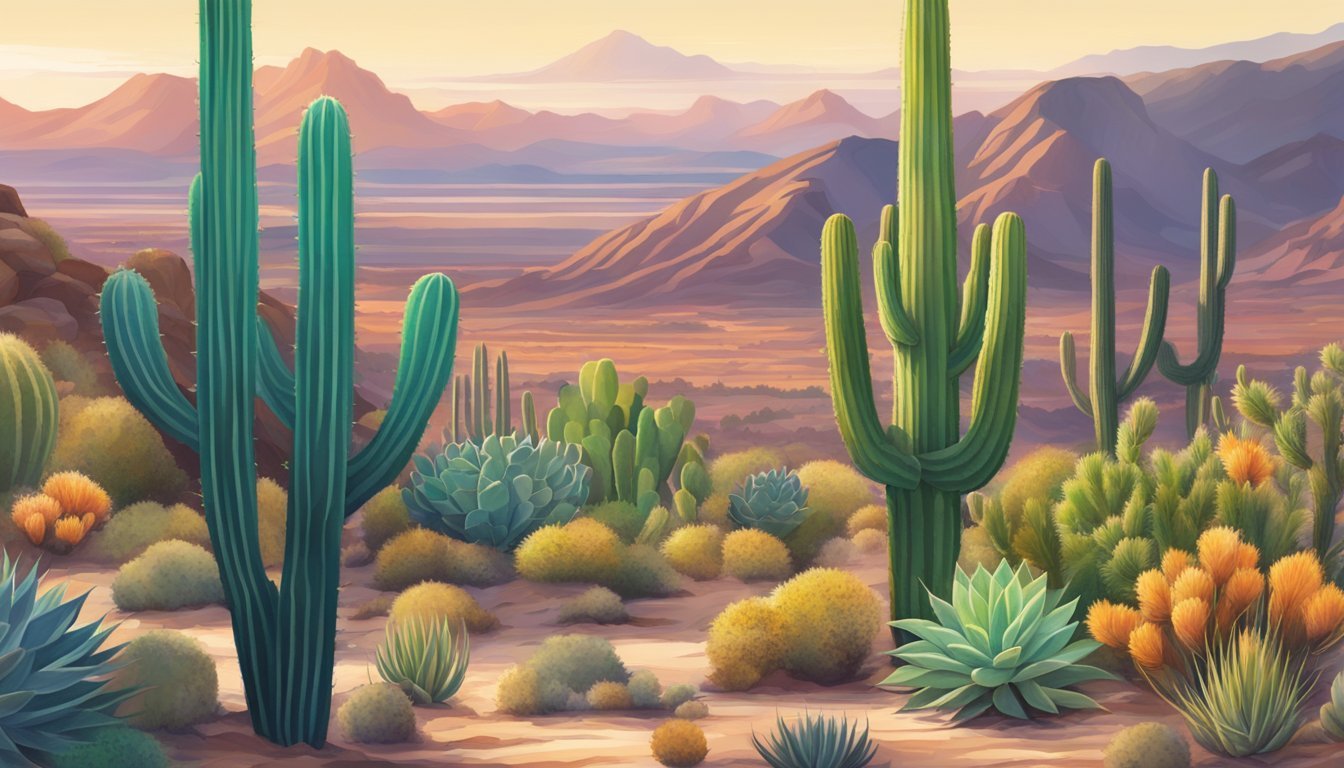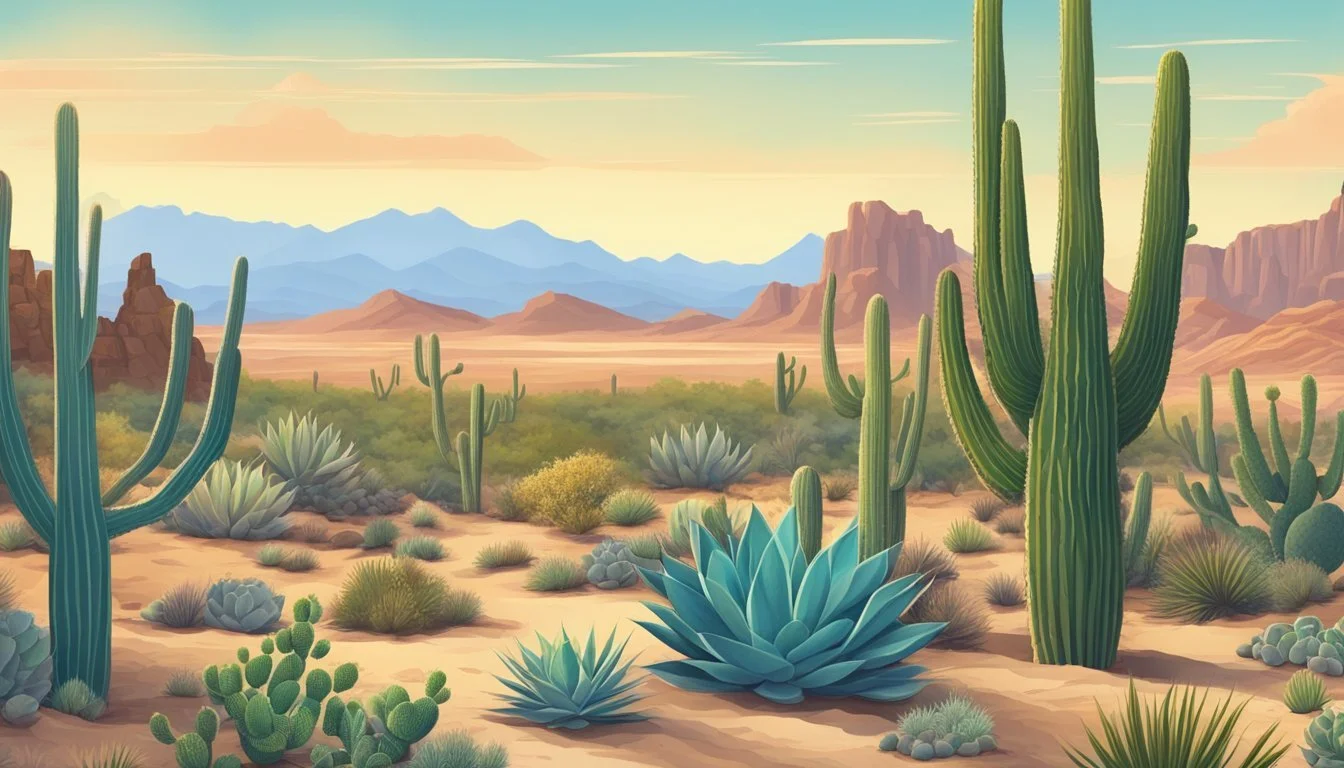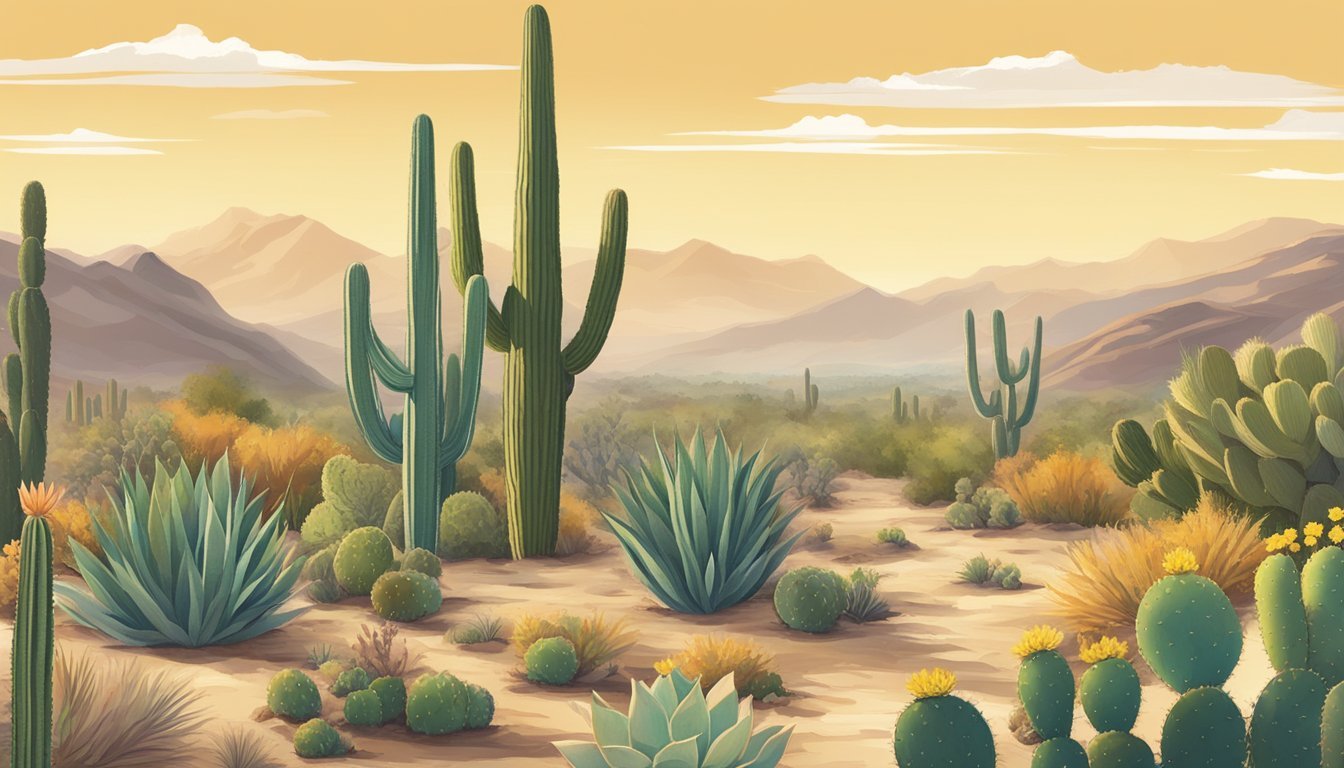Drought-Tolerant Plants in Arizona
Essentials for a Resilient Garden
Arizona's climate presents unique challenges for gardeners and landscapers, with high temperatures and low rainfall making water conservation a critical concern. Drought-tolerant plants offer a sustainable solution to this issue, allowing residents to maintain vibrant landscapes without placing excessive demands on water resources. By choosing plants adapted to the arid conditions, homeowners can cultivate gardens that are both beautiful and environmentally responsible.
These plants are not only practical but also diverse in their appearance and function. From the silvery foliage of the Blue Bells to the fast-growing, shady canopies provided by Tipu trees, there is an extensive variety of options available. They are celebrated for their low maintenance, requiring less intervention once established, thus benefiting the local ecosystem and reducing the labor and costs associated with landscaping.
The selection of drought-tolerant plants for Arizona landscapes is not limited to native species, although these are often the most suited to local conditions. Other plants that have adapted well to desert environments include specimens such as Chilean Mesquite and diverse varieties of shrubs, groundcovers, and wildflowers—all chosen for their ability to thrive in spite of limited water availability. By prioritizing these types of plants, Arizonans can enjoy lush, attractive gardens that align with the region's natural climate and water availability.
Understanding Arizona's Climate
Arizona's climate is defined by its varying climate zones, distinct seasonal rainfall patterns, and the need for water usage and conservation strategies. This unique landscape is home to the Sonoran Desert, which influences much of the state's climate conditions.
Climate Zones
Arizona features a range of climate zones, from arid deserts to alpine tundra. At lower elevations, the state falls into the hot desert climate category, particularly prevalent in the Sonoran Desert. Higher altitudes see more of a temperate climate and even alpine conditions on mountain peaks. These transitions are reflected in landscaping and gardening practices tailored to each zone's specific conditions.
Zone 4b to 10b: Arizona's USDA Plant Hardiness Zones range from the cold-hardy 4b to the warm 10b, emphasizing the state's climatic diversity. Plants selected for landscaping need to be compatible with these zone classifications.
Seasonal Rainfall Patterns
Arizona experiences two distinct rainfall patterns: the winter rains and the summer monsoon seasons.
Winter Rains: Typically gentle and spread over days, they sustain the natural vegetation and supplemented landscapes.
Summer Monsoon: This season is characterized by brief, intense downpours that can lead to flash floods. Successful plantings must be able to handle rapid changes in soil moisture levels during this period.
Water Usage and Conservation
The scarcity of water in Arizona's arid climate necessitates conservation measures. Efficient water use is a priority in all sectors, especially in agriculture and landscaping. Drought-tolerant plants are integral to conserving water resources and are increasingly utilized in both residential and public spaces.
Drought-tolerant Landscaping: Often referred to as xeriscaping, it includes native desert plants that require minimal irrigation.
Water Conservation Programs: Initiatives set forth by the Arizona Department of Water Resources promote the use of low water use and drought-tolerant plants in urban areas.
Benefits of Drought-Tolerant Plants
In the arid climate of Arizona, drought-tolerant plants offer significant advantages by reducing water consumption and providing for low-maintenance landscaping solutions, while also supporting the local ecosystem.
Reduced Watering Needs
Drought-tolerant plants have adaptations that enable them to thrive with less water, making them ideal for Arizona's environment. These adaptations include deep root systems and leaves with reduced surface area, which minimize water loss. For instance, planting selections from the essential guide to drought-tolerant plants in Arizona can result in lower utility bills and a decreased need for frequent watering, creating a garden that sustains itself even during periods of low rainfall.
Low-Maintenance Landscaping
They don't just save water; drought-tolerant plants typically require less maintenance overall. Their resilience against heat and dry conditions means that they need less frequent pruning, fertilizing, and disease management. For homeowners, this translates into less time spent on yard work and more time enjoying their outdoor spaces. Incorporating plants like those suggested in the list of full-sun thriving plants ensures a landscape that is both beautiful and easy to care for.
Ecosystem Support
Beyond individual gardens, these plants play a critical role in supporting local ecosystems. Drought-tolerant plants provide habitat and food sources for native wildlife, including pollinators like bees and butterflies. By selecting plants attuned to the local environment, gardeners help sustain the regional biodiversity. Moreover, as advised by gardening experts, choosing the right drought-tolerant plants also greatly reduces the water needed for irrigation, promoting sustainable gardening practices that contribute to water conservation efforts in the community.
Selecting Drought-Tolerant Plant Species
When designing a sustainable landscape in Arizona, it's crucial to select plant species that thrive in arid conditions. These selections typically include a variety of native plants, adaptive non-native species, and flowering plants that can survive with minimal water.
Native Plants
Arizona's native plants are the bedrock of drought-tolerant landscaping. They are well-adapted to the region's climate and soil conditions. The Saguaro cactus (Carnegiea gigantea), a symbol of the Arizona desert, is not only iconic but also exemplary of water efficiency. Another remarkable native is the Paloverde tree (Parkinsonia spp.), known for its green bark and efficient water use. These species, along with other natives like various Yucca species, contribute to a sustainable and low-maintenance landscape.
Adaptive Non-Native Species
While native plants are often preferred, there are non-native species that can also adapt well to Arizona's arid environment. Olive trees (Olea europaea) and Aleppo Pines (Pinus halepensis) have shown resilience to dry conditions once established. These plants can complement native species, offering variety in texture and form while still conserving water.
Flowering Plants
The desire for color in the landscape can be fulfilled with drought-tolerant flowering plants. Penstemon varieties, with their vibrant tubular flowers, attract pollinators while tolerating dry conditions. Lantana (Lantana camara), which blooms in a spectrum of colors, also fits well within a water-wise garden framework. Both provide a striking contrast against the more subdued greens and grays of Arizona's desert palette.
Incorporating a mix of these plant groups not only ensures survival in harsh climates but also promotes biodiversity and adds aesthetic value to Arizonan landscapes.
Designing a Drought-Tolerant Landscape
When designing a landscape that conserves water and thrives in the Arizona desert, key factors include soil optimization, strategic plant grouping, and effective mulching. These elements are essential to create a sustainable desert landscape.
Soil Preparation
Arizona's soil conditions vary, but thorough preparation ensures that even in arid conditions plants can flourish. Testing soil to determine its type—sand, clay, rock, or loam—is crucial. Amendments might be necessary; organic materials such as compost can improve water retention and drainage. For a successful desert landscape, one should:
Assess soil type and condition.
Integrate organic matter to enhance fertility and moisture retention.
Plant Grouping Strategies
Grouping plants with similar water needs promotes efficient watering practices. By doing so, one can avoid over- or under-watering different vegetation types. For instance, succulents and cacti should be grouped separately from thirstier flowering shrubs. This method supports a well-structured Arizona desert landscape where:
Plants with low water requirements are grouped together.
Thirstier plants are placed in zones that can be watered more frequently without affecting nearby drought-tolerant species.
Mulching Techniques
Mulching is a key strategy in arid landscaping. It minimizes evaporation, keeps roots cool, and suppresses weed growth. Decorative mulch not only aids in water conservation but also adds aesthetic value to the landscape. One should:
Apply a 2-3 inch layer of mulch around plants.
Choose organic mulches, such as wood chips or straw, which can also improve soil quality over time.
Planting and Maintenance Guidelines
In the arid climate of Arizona, the selection of drought-tolerant plants and efficient maintenance practices are crucial for a sustainable garden. These practices include knowing the best time and method for planting, how to water efficiently, and the proper ways to fertilize and prune.
Best Planting Practices
Choosing the right time to plant is as important as the selection of plants themselves. One should plant during a time that allows plants to establish themselves before extreme temperatures set in. Fall is often ideal, as plants can benefit from the winter rains. Desert-adapted plants typically require areas that receive full sun exposure. Ensuring proper soil preparation is critical; this often involves amending the soil to allow for better water penetration and root growth.
Irrigation Techniques
Effective watering techniques can dramatically reduce water consumption while promoting healthy plant growth. It’s essential to water deeply but infrequently, which encourages deeper root systems that are more drought resilient. Drip irrigation systems are ideal for delivering water directly to the roots with minimal evaporation. In the hottest parts of the year, it’s critical to adjust the irrigation schedule to match plant needs without over-watering.
Fertilization and Pruning
While drought-tolerant plants usually require less fertilization than others, they do benefit from the appropriate nutrients, particularly when young and establishing. Use a balanced, slow-release fertilizer in the recommended quantities. Pruning is an integral part of plant maintenance that not only maintains the desired shape and size but also encourages new growth and vigour. Prune during the dormant season and always with clean, sharp tools to prevent disease.
By adhering to these guidelines, one can enjoy a vibrant, resilient landscape that is well-suited to the challenges of the Arizona climate.
Featured Drought-Tolerant Plants
In Arizona's dry climate, landscaping with drought-tolerant plants is crucial. These featured plants are highly adapted to thrive with minimal water, ensuring vibrant gardens even under arid conditions.
Agave and Yucca
Agaves and yuccas are cornerstone plants for drought-tolerant gardens in Arizona. The Agave americana, commonly known as the century plant, is a statement feature with its large rosettes of tough, pointed leaves. In contrast, the Yucca elata, or soaptree yucca, provides a vertical element with its tall spikes and white, bell-shaped flowers. Both are exemplary in their low water needs and striking silhouettes.
Succulents and Cacti
Succulents and cacti are synonymous with the desert environment. Well-known for their water-storing capabilities, these plants are ideal for Arizona's climate. Opuntia, or prickly pear, offers both visual appeal and practicality with its distinctive pads and edible fruits. Other cacti, like the iconic Saguaro, become sculptural elements in the landscape while requiring minimal water.
Shrubs and Trees
Selecting the right shrubs and trees can transform an arid garden into a lush oasis. The Palo Verde, with its green bark and bright yellow flowers, is a water-wise tree that provides dappled shade. Texas sage and mesquites are other durable options, well-regarded for their resilience and beauty. The Arizona rosewood serves as an excellent evergreen alternative to the toxic oleander, requiring far less water.
Perennials and Groundcovers
Incorporating drought-tolerant perennials and groundcovers adds color and diversity. Delightful blooms of Angelita daisy and penstemon introduce bursts of color with minimal upkeep. Verbena provides a cascading effect with its clusters of vibrant flowers. For a touch of the tropics, bougainvillea thrives in Arizona's heat, offering bright, paper-like bracts around tiny flowers.
Resources for Gardeners and Landscapers
For those interested in cultivating drought-resistant landscapes in Arizona, a wide array of resources is available. Gardeners and landscapers rely on these sources for plants, expertise, and community support.
Local Nurseries and Garden Centers
SummerWinds Nursery stands out as a trusted local nursery that provides a diverse selection of drought-tolerant plants suitable for Arizona's climate. The knowledgeable staff can guide gardeners to ensure that they select the right plants for their specific landscape needs.
Nurseries and Garden Centers:
SummerWinds Nursery: Offers a variety of drought-tolerant plants with expert advice.
Other Local Nurseries: Stock an array of native and adapted plants.
Desert Botanical Gardens
The Desert Botanical Garden serves as both a wonderful place to visit and a valuable educational resource. Gardeners can find inspiration among the well-documented plant species and take advantage of plant sales, where they can procure rare and desert-adapted species.
Educational Resources:
Garden Advisors: Specialists are available to provide information and recommendations for sustainable gardening practices.
Online Horticultural Communities
Virtual communities afford gardeners the opportunity to connect, exchange knowledge, and get advice from fellow enthusiasts. These online platforms provide forums where one can discuss challenges and triumphs in desert gardening.
Online Forums: They offer a platform for gardeners to seek advice and share experiences.
Frequently Asked Questions
This section addresses common inquiries regarding plant choices for the arid Arizona climate, focusing on those that offer both aesthetic appeal and sustainability.
What are some low maintenance plants that thrive in Arizona's desert landscape?
Low maintenance plants suited for Arizona's desert landscape include aloe vera, agave varieties, and desert marigold. These plants require minimal watering and care, making them ideal for the state's dry conditions.
Which are the best heat-tolerant shrubs suitable for an Arizona backyard?
Heat-tolerant shrubs such as lantana, Texas sage, and bougainvillea are well-suited for Arizona backyards. Their ability to withstand high temperatures without significant water input makes them a practical choice for gardeners.
What drought-resistant trees are recommended for Arizona climates?
For those seeking drought-resistant trees, the mesquite tree, palo verde, and ironwood are excellent options for Arizona's environment. They are known for their resilience and capacity to thrive with limited water.
Can you list evergreen plants that are drought-tolerant and can grow in Arizona?
Several evergreen plants that are both drought-tolerant and suitable for growth in Arizona include the rosemary shrub, Indian hawthorn, and Arizona cypress. These evergreens provide year-round greenery with minimal water requirements.
What are the top desert plants that can withstand full sun exposure in Arizona?
Top desert plants that are adept at withstanding full sun exposure include the golden barrel cactus, ocotillo, and red yucca. These plants are specifically adapted to thrive under the intense Arizona sun.
Which resilient desert plants are known to be the most drought-resistant?
Among the most drought-resistant desert plants are the saguaro cactus, Joshua tree, and brittlebush. They are notable for their exceptional ability to survive long periods without water, exemplifying the resilience of desert flora.





